How Professional Wellbeing Boosts Workplace Engagement & Retention
Last Updated Sep 17, 2025

Work is where people spend most of their waking hours—so why is feeling good at work still the exception, not the rule?
Every day, employees show up exhausted, anxious, and stretched thin. And it’s not just their problem—it’s yours. Because when professional wellbeing tanks, performance follows. Quiet quitting rises. Innovation stalls. Turnover explodes. The cost? Millions in lost productivity, healthcare claims, and top-tier talent walking out the door.
But it doesn’t have to be this way. When employees feel healthy, supported, and purposeful in their roles, they do more than just “get the job done”—they thrive. They bring energy, creativity, and loyalty to the table. And they stick around.
Ready to shift from burnout to breakthrough?
Unlock the secrets to building a culture of professional wellbeing that fuels resilience, retention, and results.
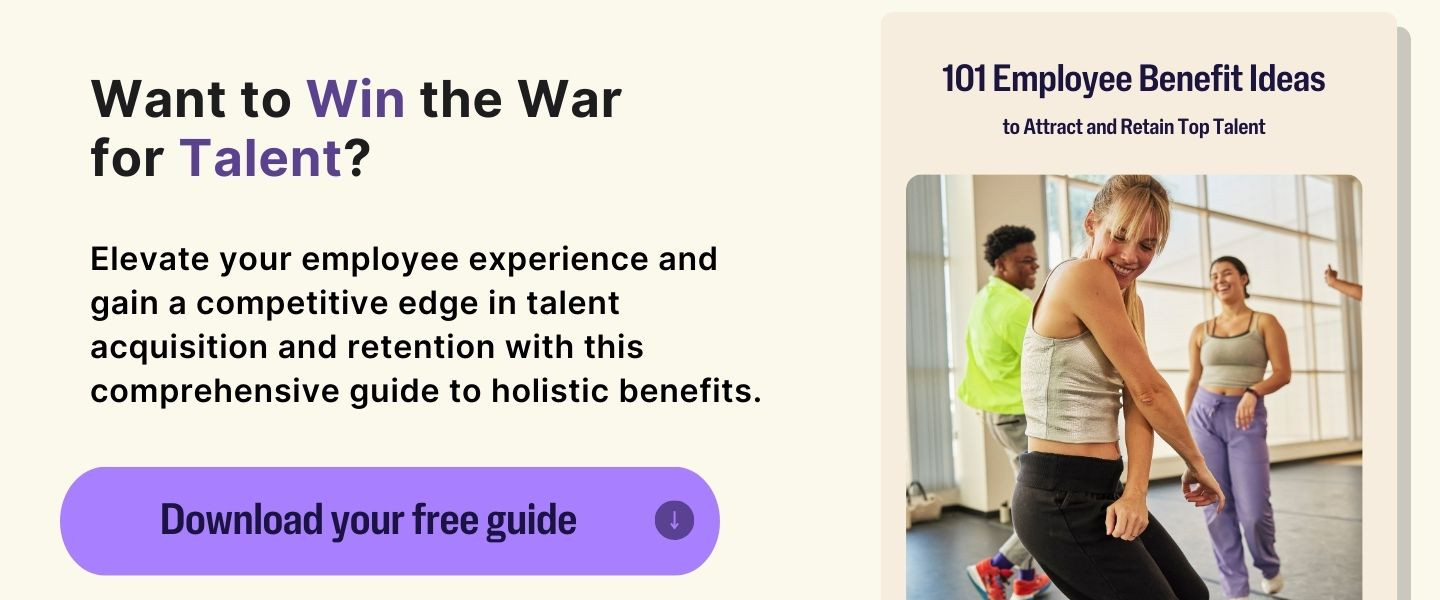
What You’ll Learn:
- Wellbeing Drives Performance: When employees thrive, companies reap the rewards. Thriving workers miss 53% fewer work days for health reasons and are 32% less likely to seek a new job.
- The Cost of Neglect is High: Poor professional wellbeing fuels disengagement, burnout, and turnover. Burned-out employees are six times more likely to plan a quit, and burnout is estimated to cost employers $4,000 to $21,000 per employee each year in lost output and health costs.
- Five Pillars for a Thriving Workforce: Effective wellbeing programs tackle mental health, work-life balance, physical health, professional growth, and social belonging together. Holistic strategies addressing all five areas far outperform one-off perks – and are essential for sustainable engagement.
- HR’s Role in Culture Change: Lasting improvements require systemic change, not just wellness apps. Leadership and culture set the tone – fostering psychological safety, flexible work, and growth opportunities. HR can lead the charge by aligning policies and manager training to make wellbeing part of everyday work life.
- ROI You Can Measure: Ninety five percent of companies who track wellbeing ROI see positive returns. From lower healthcare spend to higher talent attraction, you can (and should) quantify the business impact. We’ll show you how to implement initiatives and measure success for continuous improvement.
What is Professional Wellbeing?
Professional wellbeing is a person’s overall sense of health, satisfaction, and purpose at work. It reflects how supported, valued, and balanced they feel in their role—physically, mentally, socially, and financially.
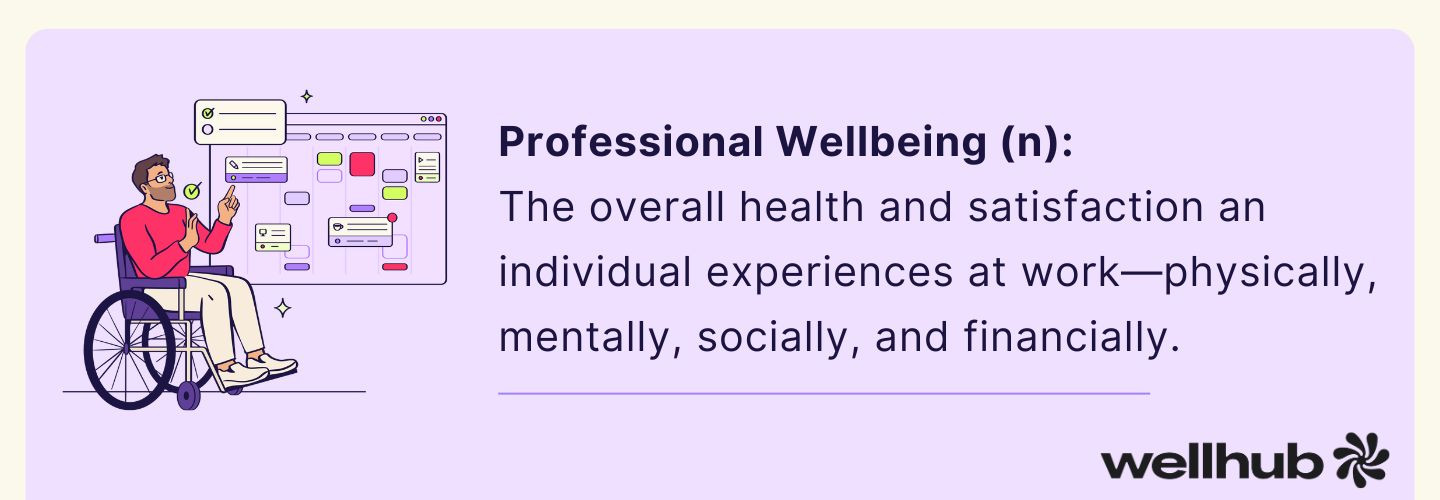
When professional wellbeing is high, employees are more engaged, resilient, and productive. When it's low, burnout, absenteeism, and turnover rise.
At its core, professional wellbeing includes:
- Physical health at work — having the time and resources to stay active, eat well, and manage rest. Yet, 71% of workers report sleeping less than seven hours per night, which directly impacts their performance.
- Mental and emotional balance — being able to handle stress, avoid burnout, and access support like therapy or mindfulness tools. In fact, 47% of employees say work stress is actively degrading their mental wellbeing.
- Financial security — confidence in benefits, fair pay, and the ability to afford wellness. Nearly 68% of employees say their financial situation prevents them from investing in their overall wellbeing.
- Purpose and growth — knowing their work has meaning, and having opportunities for development, recognition, and career advancement.
- Belonging and inclusion — feeling safe, respected, and included in the workplace culture.
As you can see from that list, professional wellbeing isn’t just about individual grit or personal habits — it’s shaped, first and foremost, by the environment people work in every day. Research shows it correlates strongly with factors like job satisfaction, feeling valued, having growth opportunities, and a positive workplace climate.
That means HR leaders have real power here. From workload expectations to growth opportunities, leadership behaviors to support systems — every part of the workplace either fuels or frustrates employee wellbeing. When people feel valued, supported, and set up to grow, their professional wellbeing is set to soar.
Dive deep into how workplace wellness can make your organization more successful.
How Professional Wellbeing Impacts Employee Performance (2025 U.S. Stats)
Poor professional wellbeing just a “people problem” – it’s a direct threat to organizational performance. Disengagement, absenteeism, errors, turnover…these are the costly symptoms when employees’ needs are unfulfilled.
Let’s look at the numbers:
- Engagement & Productivity: Gallup’s latest data shows only 31% of U.S. employees are engaged at work, while 17% are actively disengaged – essentially “checked out.” This disengagement often stems from burnout and low wellbeing. Stressed, unhappy employees simply don’t have the bandwidth to go above and beyond. They may resort to “quiet quitting” – doing the bare minimum – which drags down productivity and innovation. It’s estimated by Gallup that lost productivity from disengaged workers cost the global economy $9.6 trillion last year.
On the flip side, engaged employees with high wellbeing are far more productive and creative. They even have significantly higher customer loyalty and profitability outcomes. In essence, wellbeing fuels the enthusiasm and focus that drive performance.
- Turnover & Talent Retention: Burnout and poor wellbeing are like a revolving door for talent. Surveys by McKinsey found burned-out employees are six times more likely to be planning to quit in the next six months. They’re also less likely to recommend your company to others.
This translates into hard costs: replacing a departing employee can cost up to twice their annual salary in recruiting and training. Consider a 1,000-person organization – burnout-related turnover alone could be costing $5 million or more per year. Moreover, a toxic or neglectful culture can tank your employer brand. Nearly 9 out of ten employees won’t even apply to a company that lacks a clear emphasis on wellbeing.
In today’s market, top talent scrutinizes culture: 92% of workers say it’s important that their employer values their emotional and psychological wellbeing. Companies that invest in wellbeing have a recruiting edge, while those that don’t are bleeding talent to competitors that do.
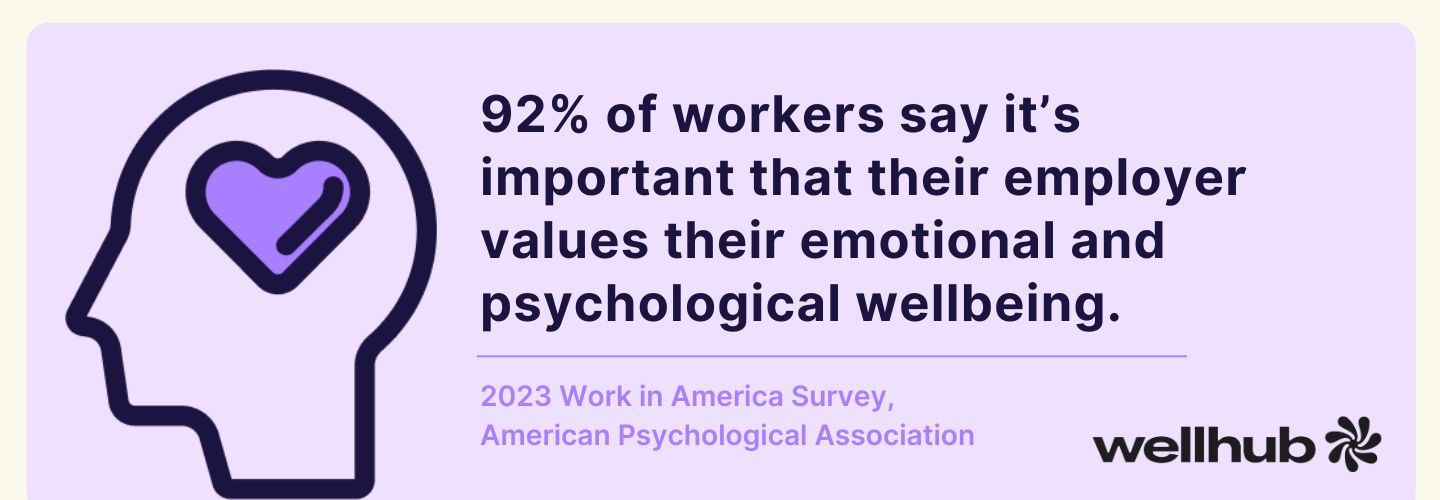
- Healthcare Costs & Absenteeism: When employees’ wellbeing falters, health costs rise – both for them and the company. Stress-related illnesses (mental health disorders, heart disease, etc.) drive up medical claims. Workplace burnout has been linked with an estimated $125 to 190 billion in healthcare spending annually in the U.S. — that's up to 8% of total healthcare spending.
Unwell employees also miss more work. Whether it’s stress-induced sick days or “presenteeism” (showing up but performing poorly), the hours lost are substantial. Burned-out workers tend to struggle with cognitive impairment – memory issues, difficulty concentrating – which means even when present, they’re not fully productive.
By contrast, employees who report high wellbeing take far fewer sick days. Gallup finds that employees who are “thriving” in their overall lives miss 53% fewer work days due to health issues. They also exhibit more resilience under stress. In short, supporting wellbeing can significantly reduce costly absenteeism and keep your team operating at full capacity.
- Innovation & Quality: Professional wellbeing even impacts how much discretionary effort and creativity people bring to work. Stressed or disengaged employees are often in “survival mode,” doing only what’s necessary. In one study, burnout corresponded with lower cognitive flexibility and problem-solving ability – the mental skills essential for innovation.
On the other hand, employees who feel good and supported at work are more likely to go the extra mile – brainstorming ideas, pursuing continuous improvement, delivering great service. They have the mental space to be creative. It’s telling that some of the most innovative companies also top “best workplaces” lists—think Nvidia, Salesforce, Adobe, and Cisco—suggesting a strong culture of wellbeing underpins their success. When people have the energy and positive mindset that come with high wellbeing, they contribute more of their talents to the organization.
In tangible terms, prioritizing wellbeing pays off. A study by Wellhub found that among companies measuring the ROI of wellness programs, 95% saw positive returns – up from 90% a year prior. Many organizations now recoup $2 to $3 for every $1 invested in employee wellbeing through lower turnover, reduced sick time, and improved productivity. In fact, HR leaders in the survey reported major benefits: Nearly all see productivity gains, and large majorities report lower healthcare costs, fewer sick days, and improved retention as a direct result of their wellness initiatives.
The data makes it plain: professional wellbeing drives performance. When employees are healthy, balanced, and supported, they bring their best selves to work. They collaborate better, serve customers better, and have the capacity to innovate. And they stick around. For HR leaders concerned with engagement, productivity, and ROI, investing in wellbeing is one of the smartest moves you can make.
Launch a wellness program thatlifts engagement and lowers costs.
Core Pillars of a Comprehensive Professional Wellbeing Strategy
To improve professional wellbeing effectively, organizations need a comprehensive strategy. Quick fixes or standalone perks won’t move the needle. Instead, leading HR teams structure their wellbeing efforts around five core pillars that reflect employees’ fundamental needs:
Providing support for stress, anxiety, and overall mental wellness. This includes resources like counseling or Employee Assistance Programs, mental health days, and a workplace culture that normalizes seeking help. Why? Because work is a major source of stress – more than three in four U.S. workers report at least one mental health symptom in the past year – and unaddressed mental health issues erode performance and morale.
Enabling employees to have a healthy integration of work with their personal life. This pillar involves reasonable workload expectations, flexible schedules, remote work options, respect for boundaries (like discouraging after-hours emails), and encouraging people to use their vacation time. With 95% of workers saying it’s important their employer respects work-life boundaries, this pillar is critical to prevent burnout.
Supporting employees’ physical wellbeing through wellness programs, fitness opportunities, nutrition, and preventive care. Examples include subsidized gym memberships or fitness classes, on-site health screenings, wellness challenges, and ergonomic workplaces. Healthy employees feel more energized, more engaged, and take fewer sick days. In fact, a meta-analysis of 56 studies on workplace health promotion programs found that organizations of all sizes saw big benefits—a 25% drop in sick leave, health plan costs, and workers’ comp and disability expenses.
Fostering career development, continuous learning, and a sense of purpose at work. This pillar ensures employees have opportunities to learn new skills, advance in their careers, and feel that their work matters. Tactics include training programs, tuition reimbursement, mentoring, clear career paths, and recognition of achievements. Growth and meaning are huge for engagement – feeling “stuck” is a recipe for disengagement: 89% of workers say that professional development in their field is important to keeping them engaged at work.

Creating an inclusive culture where employees feel connected, valued, and part of a community. This means nurturing positive team relationships, providing peer support networks or Employee Resource Groups, and promoting diversity, equity, and inclusion. A sense of belonging at work has been linked to higher job satisfaction and lower turnover. (Notably, 95% of workers say feeling respected and valued is extremely important to their wellbeing.)
These five pillars are interrelated. For instance, if someone’s workload (work-life pillar) is out of control, their mental health will likely suffer. Or if an employee feels no one cares about them (belonging), their mental and even physical health can decline.
Here’s how to find a whole-person wellness program that boosts performance.
A comprehensive wellbeing strategy addresses all pillars, creating a holistic safety net. It aligns closely with frameworks like the U.S. Surgeon General’s Five Essentials for Workplace Well-Being, which emphasize protection from harm, connection, work-life harmony, mattering, and growth — essentially the same themes. By designing initiatives under each pillar, you ensure no aspect of employee wellbeing is overlooked. The result is a more resilient, engaged workforce.
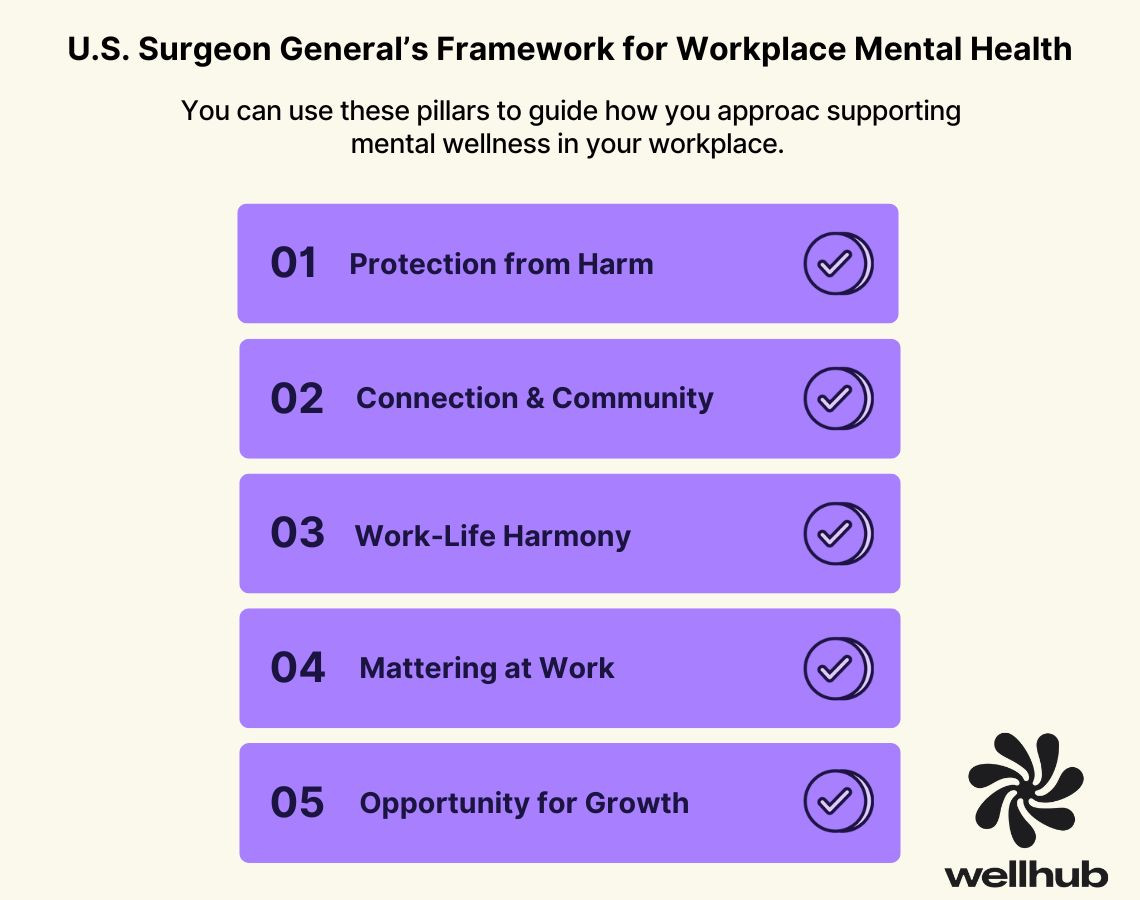
20 Ways HR Can Improve Professional Wellbeing
HR leaders are uniquely positioned to champion professional wellbeing. You control policies, programs, and cultural initiatives that can dramatically improve employees’ day-to-day experience. Here are 20 key ways HR can boost wellbeing – each corresponding to one of the core pillars above – along with actionable steps and examples.
- Prioritize and Support Mental Health
Make mental health a visible priority in your organization. This starts with acknowledging that everyone has mental health, and it can be challenged by work stress. HR can lead the way by implementing programs and policies that support employees’ emotional and psychological wellbeing:
- Offer Robust Mental Wellness Resources: Ensure your benefits include accessible, confidential mental health services. This might be an Employee Assistance Program (EAP) offering free counseling sessions, access to therapists through your health plan, or even on-site/virtual counseling services. Promote these resources frequently, so employees know what’s available. For example, Microsoft provides comprehensive mental health support through its “Wellbeing @ Microsoft” initiative, including a strong EAP and free counseling sessions, contributing to a 22% increase in employee satisfaction and lower stress reports.
- Normalize Mental Health Conversations: Create a culture where it’s okay to talk about stress, anxiety, or burnout without stigma. Leaders and managers should openly discuss mental wellness – for instance, sharing times they felt overwhelmed and sought help. In fact, 90% of employees appreciate when leaders are open about their own mental health journeys. This kind of leadership vulnerability sends a powerful message that it’s safe to seek support. Also, train managers to recognize signs of distress and approach those conversations with empathy (e.g. “How are you coping? What can we adjust to help?”).
- Provide Mental Health Days and Flexibility: Sometimes rest is the best remedy. Consider offering dedicated mental health days (separate from PTO) or simply encourage staff to use sick days for mental wellbeing without guilt. Embed flexibility so employees can attend therapy appointments or take a midday walk to decompress. One survey found 81% of workers will be looking for employers that support mental health in the future – flexibility is a big part of that support. HR can update leave policies to explicitly include mental health as a valid reason for time off.
- Educate and Build Awareness: Host workshops or lunch-and-learns on topics like stress management, mindfulness, or building resilience. Partner with mental health organizations to run awareness campaigns (for example, marking World Mental Health Day with internal events). The goal is to equip employees with coping skills and to reinforce that seeking help is a sign of strength.
By proactively addressing mental health, HR can mitigate the huge toll of stress and burnout. You’ll know you’re succeeding when employees feel they won’t be judged for saying “I’m feeling burned out” and when they actually utilize the counseling, coaching, or self-care resources your company provides. In turn, you can expect to see improved focus, morale, and productivity – because employees can bring their whole selves to work when their mental health is cared for.
Strengthen workplace mental health:
- 7 proven strategies to strengthen emotional wellness at work
- Build psychological safety with these data-backed strategies
- Encourage Work-Life Wellness and Flexibility
Work-life wellness is not a mere slogan – it’s a critical component of wellbeing. When employees chronically overwork or can’t juggle personal responsibilities, stress spikes and performance suffers. HR can implement policies to ensure a positive work experience:
- Set Reasonable Boundaries and Expectations: Review workloads and hours in your organization. Are people routinely logging 60-hour weeks or answering emails at midnight? That’s a red flag. Work with leadership to establish norms like “no emails after hours” or blocking meeting-free lunch hours. Model these behaviors from the top. Remember, 95% of employees highly value leaders respecting non-work time. If leadership sends emails at 11pm, employees feel compelled to do the same – so set a better example by disconnecting. Some companies even implement company-wide “quiet hours” each evening or meeting curfews to protect personal time.
- Offer Flexible Schedules and Remote Options: Wherever business can accommodate it, give employees more control over when and where they work. This could mean flexible start/end times, compressed workweeks, or generous remote work policies. Flexibility is the number one thing workers crave post-pandemic – 94% of employees say they want flexibility in their schedule. HR can pilot flexible arrangements in different teams and use employee feedback to refine them. The outcome is often win-win: employees can better integrate life needs (school drop-offs, exercise, etc.), and employers still get quality work (often with higher loyalty and output).
- Encourage Time Off and Rest: Ensure employees actually take their vacations and breaks. HR can monitor PTO usage and gently nudge those who haven’t taken time off in a while. During the workday, promote a culture where taking a lunch break or a brief walk is accepted (not a sign of slacking). Being “always on” is detrimental – research shows that insufficient rest and long hours increase risk of exhaustion, anxiety, and depression. You might start initiatives like “Recharge Fridays” (closing early on certain Fridays in summer) or company-wide holidays to enforce rest. Some organizations have even experimented with 4-day workweeks to combat burnout – and report maintained or improved productivity as a result.
- Accommodate Personal Needs: Life events and responsibilities (from child care to elder care to personal health issues) will inevitably conflict with work at times. HR’s role is to provide understanding and flexibility in these moments. That might include remote work options, job sharing, part-time arrangements, or simply a manager mindset of “get your work done, but if you need to step away for an hour to handle a personal task, that’s fine.” The more trusted and empowered employees feel to manage their work and life, the more loyalty and dedication they’ll return. A company that supported an employee through a difficult life event often earns a committed employee for years.
Ultimately, preventing overwork and burnout is a strategic imperative. When HR fosters work-life balance, employees are healthier, happier, and actually more productive. They experience less chronic stress and burnout – which means fewer mistakes and lower turnover. In industries notorious for poor balance (e.g. hospitality, consulting), those that buck the trend with humane schedules gain a competitive talent advantage. Your efforts here send a clear signal: “We value you as a whole person, not just a worker.” That sentiment pays off in engagement.
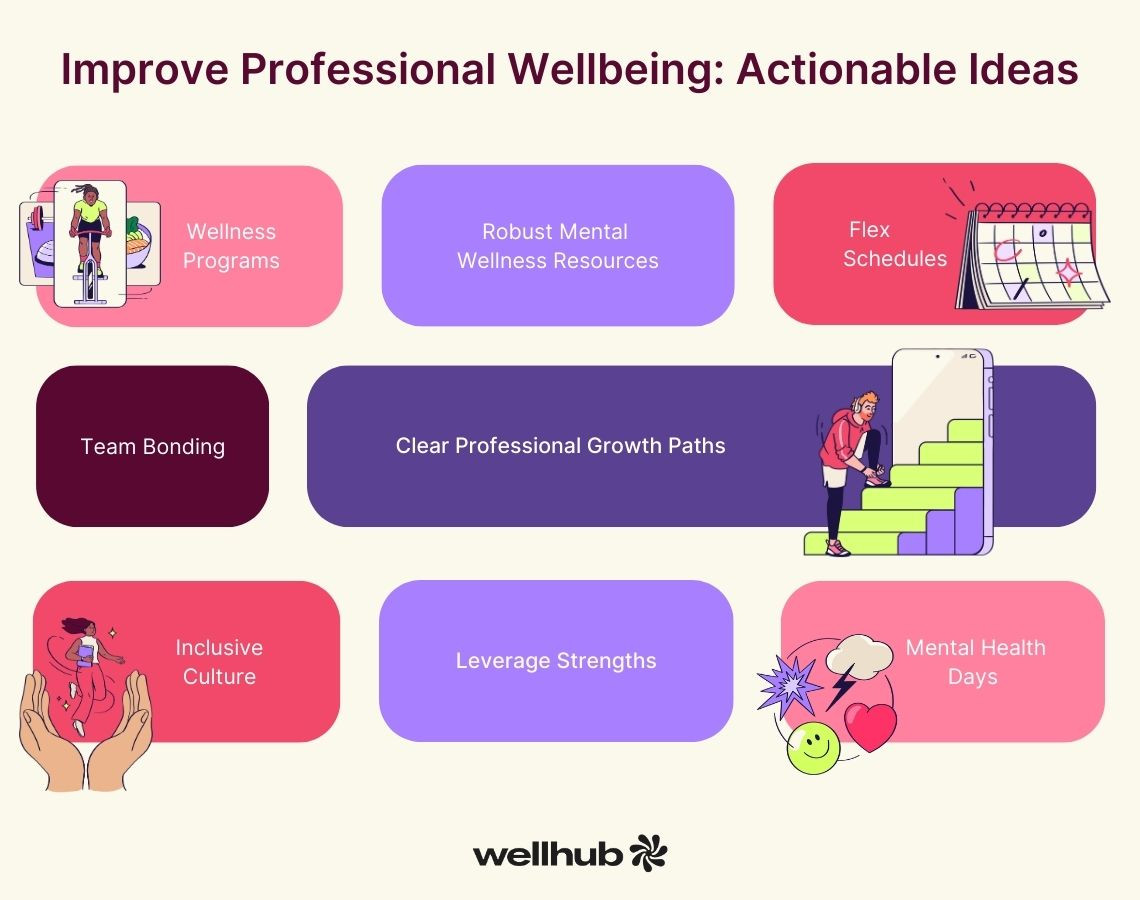
- Promote Physical Health and Wellness
Physical wellness is a foundational pillar of overall wellbeing – and it’s an area where HR can have an immediate impact through wellness programs and benefits. Supporting employees’ physical health leads to more energy, fewer sick days, and higher performance on the job. Here’s how HR can boost this pillar:
- Implement Comprehensive Wellness Programs: A strong wellness program goes beyond health insurance. Think in terms of programs that encourage healthy habits. Popular components include: subsidized gym memberships or fitness app access (e.g. offering Wellhub to give employees access to hundreds of gyms and wellness apps), step or activity challenges with fun incentives, on-site yoga or fitness classes, and lunch-and-learns on nutrition or ergonomics. The key is to offer a variety of activities to engage different interests – from meditation sessions to fun runs. Companies with holistic programs (addressing exercise, nutrition, sleep, etc.) see big payoffs: effective workplace health programs have been shown to cut absenteeism by about 25% and can reduce health costs substantially over time.
- Offer Preventive Health Resources: Make it easy for employees to take care of their health. HR can organize on-site health screenings (blood pressure, cholesterol, etc.), flu shot clinics, or mobile mammography units. You might negotiate discounts for employees on programs like weight management, smoking cessation, or diabetes prevention. Ensure your health insurance covers annual physicals and preventive care at 100%. When employees catch health issues early or maintain healthy numbers, it prevents costly problems later – for them and the company. Tip: Track participation in these preventive measures; often a majority of eligible employees will participate if it’s convenient and endorsed by leadership (“We care about your health – take advantage of this!”).
- Encourage Movement and Healthy Breaks: Desk work can be very sedentary, especially with remote setups. HR can help employees build movement into their day. Simple initiatives: encourage walking meetings or stretch breaks, provide standing desks or ergonomic desk setups on request, and perhaps implement “activity prompts” (some companies use software that nudges workers to take a 5-minute stretch). Also consider facilities: is there a safe space to take a walk near the office? Does your office have a mother’s room or relaxation/nap room? These physical environment tweaks show you prioritize employees’ health. Fifty-six percent of employees report fewer sick days when they participate in wellness programs, and adding a bit of movement can translate into better focus and mood for the rest of the day.
- Nutrition and Healthy Eating: Physical wellbeing isn’t just exercise – nutrition plays a huge role. If you have on-site cafeterias or vending, work with vendors to offer healthy choices (and perhaps subsidize those to make them appealing). You could host healthy cooking demonstrations or share nutritious recipes in internal newsletters. During company events, include healthy options (not just cookies and soda). Hydration is important too – provide water coolers or even branded water bottles to encourage water over sugary drinks. These might seem like small things, but they build a culture where healthy choices are the norm. Over time, better nutrition supports better energy levels and immune function among your staff.
The bottom line: fit, healthy employees perform better and cost less (in terms of healthcare and absence). One landmark Harvard study found that every $1 invested in wellness yielded about $3 in health cost savings due to reduced medical claims and absenteeism. While results vary, the consensus is that a well-run wellness program produces a positive ROI. HR’s challenge is to make wellness engaging – not a chore. Solicit employee input on what activities they’d enjoy. Celebrate milestones (like someone completing a 5K or quitting smoking). When employees see the company actively supporting their health, it builds goodwill and improves their day-to-day quality of life at work.
Get employees moving:
- 30 workplace wellness activities
- 17 plug-and-play physical wellness ideas
- 5 actionable employee fitness challenge ideas
- The Ultimate Guide to Workplace Wellness Challenges for HR Leaders
- Foster Professional Growth and Learning
To feel truly “well” at work, employees need to feel that they are growing and advancing in their careers. Stagnation breeds disengagement. HR can invigorate professional wellbeing by nurturing each person’s development and sense of purpose on the job:
- Create Clear Growth Paths: Work with managers to map out career paths and advancement criteria for roles in your organization. Employees should know how they can progress – whether that’s a promotion track or opportunities to take on new responsibilities. Conduct regular career development conversations. When people see a future with your company, they’re more engaged. It’s telling that in a recent survey, only 30% of U.S. employees strongly agreed someone at work encourages their development – a sobering statistic. HR can turn that around by training managers to become career coaches for their teams. Even lateral growth (new skills, project leadership) counts; it’s not just about titles.
- Offer Training and Continuous Learning: Invest in upskilling your workforce. This could be through formal training programs, e-learning subscriptions, tuition reimbursement for further education, or sending employees to conferences (even virtually). A learning culture keeps employees intellectually stimulated and shows you’re invested in their long-term success. Some companies establish a yearly stipend employees can use for any professional development of their choice. Others have formal mentorship programs to transfer knowledge from senior to junior staff. According to the Surgeon General’s framework, “Opportunity for Growth” – including learning and accomplishment – is one of the five essentials for a healthy workplace. By feeding employees’ curiosity and honing their skills, you also benefit from a more skilled, agile team.
- Recognize and Leverage Strengths: Part of professional growth is feeling a sense of accomplishment and meaning. HR can encourage managers to recognize employees’ achievements frequently – not just at annual reviews. Implement programs for recognition (peer shout-outs, monthly awards tied to company values, etc.). Additionally, try to align roles with individuals’ strengths and passions. If someone on your team is eager about a certain domain, give them stretch assignments in that area. People thrive when they can use their talents and see that their work has impact. Example: Salesforce’s “Wellness at Salesforce” program doesn’t stop at fitness; it also emphasizes giving back and finding purpose, which helps employees connect their work to something bigger – fueling engagement and a 34% stress reduction internally.
- Ensure Fairness and Respect: Growth also stalls when employees feel stuck due to bias or favoritism. HR must ensure promotions and opportunities are awarded fairly. Use diverse panels for promotions, track metrics on internal mobility by demographic to catch any inequities, and make sure credit is given where due. Part of professional wellbeing is simply knowing “my work and ideas are respected.” In fact, 95% of workers said feeling respected at work is important to them. A fair, inclusive workplace is foundational to that respect. When employees trust the system is merit-based, they stay motivated to contribute and grow.
By investing in employees’ professional growth, you fulfill a core psychological need: the need to progress and achieve mastery. This leads to higher engagement and loyalty – employees see a future for themselves with your company. They are also better equipped to take on new challenges, which helps your organization innovate and adapt. From an ROI standpoint, robust development programs can reduce turnover (people are less likely to quit if they’re learning and advancing) and build a stronger internal talent pipeline, saving costs on external hires. It’s truly a win-win: help your people grow, and your business will grow too.
- Cultivate Social Connections and Belonging
Humans are social creatures, and work is a social environment. Feeling isolated or alienated at work is a fast track to disengagement. Conversely, employees who feel a strong sense of belonging will go the extra mile and stick around. HR can implement initiatives to strengthen team connections and an inclusive culture:
- Build an Inclusive Culture: Make sure everyone in your organization feels valued and included. This starts with top-down commitment to diversity, equity, and inclusion (DEI). HR should lead DEI training and education to raise awareness of unconscious biases and promote empathy. Review your HR practices (hiring, promotions, pay) for equity. When employees see fairness and representation at all levels, it fosters trust and belonging. Also celebrate the diversity within your team – acknowledge cultural holidays, invite employees to share about their backgrounds, and ensure company communications use inclusive language. An environment where people can “bring their whole selves” to work without fear is crucial for wellbeing.
- Encourage Team Bonding and Camaraderie: Strong social bonds at work can act as a buffer against stress. HR can facilitate team-building activities, both work-related (collaborative projects, innovation hackathons) and purely social (happy hours, virtual game nights, offsite retreats). Create opportunities for employees to form real friendships. Even small practices like kicking off team meetings with personal check-ins (“How was your weekend?”) or instituting mentorship/buddy systems for new hires can make a difference. Gallup has found that having a best friend at work is correlated with higher productivity and engagement– while you can’t force friendships, you can create a friendly, social workplace where connections flourish.
- Support Employee Resource Groups (ERGs): ERGs or affinity groups (for example, networks for women, LGBTQ+ employees, parents, veterans, etc.) provide invaluable peer support and community. HR should actively support these groups with time and budget. Encourage their formation if you don’t have any, and listen to their feedback on improving the culture. These groups often spearhead inclusive programming and help underrepresented employees feel heard, which bolsters belonging. When people find a community at work, they’re far more likely to stay – it’s harder to leave your “work family.”
- Show Care and Empathy at the Individual Level: Train managers in empathetic leadership – small acts like checking in on an employee having a hard time, or celebrating personal milestones (birthdays, work anniversaries) can massively boost someone’s feeling of being cared about. Unfortunately, only 39% of U.S. employees strongly feel their supervisor or someone at work cares about them as a person. That’s a lot of people feeling undervalued. HR can shift this by weaving “care” into leadership development. For example, teach managers to regularly ask their team members how they’re doing, and to actively listen. Recognize managers who excel at building team morale and mutual support. Sometimes HR might lead by example – e.g., during crises or tough times (like the pandemic), sending company-wide notes emphasizing available support and encouraging colleagues to look out for one another.
When employees enjoy coming to work because they like the people they work with and feel genuinely accepted, it creates a powerful positive feedback loop. Belonging has been linked to a 50% drop in turnover risk and a significant boost in job performance in some studies. People simply perform better when they feel safe, included, and part of a team. For HR, focusing on social wellbeing isn’t fluff – it’s smart strategy. It turns your company into a community, and communities are resilient. They weather challenges better because people support each other. In sum, investing in the social fabric of your workplace strengthens not only wellbeing, but also communication, collaboration, and retention company-wide.
How to Implement and Measure Wellbeing Initiatives
Designing great wellbeing programs is only half the battle – the other half is implementing them effectively and measuring their impact. HR leaders must approach wellbeing initiatives with the same rigor as any business strategy: set goals, track progress, and iterate based on data. Here’s a roadmap to successfully roll out and evaluate your wellbeing initiatives:
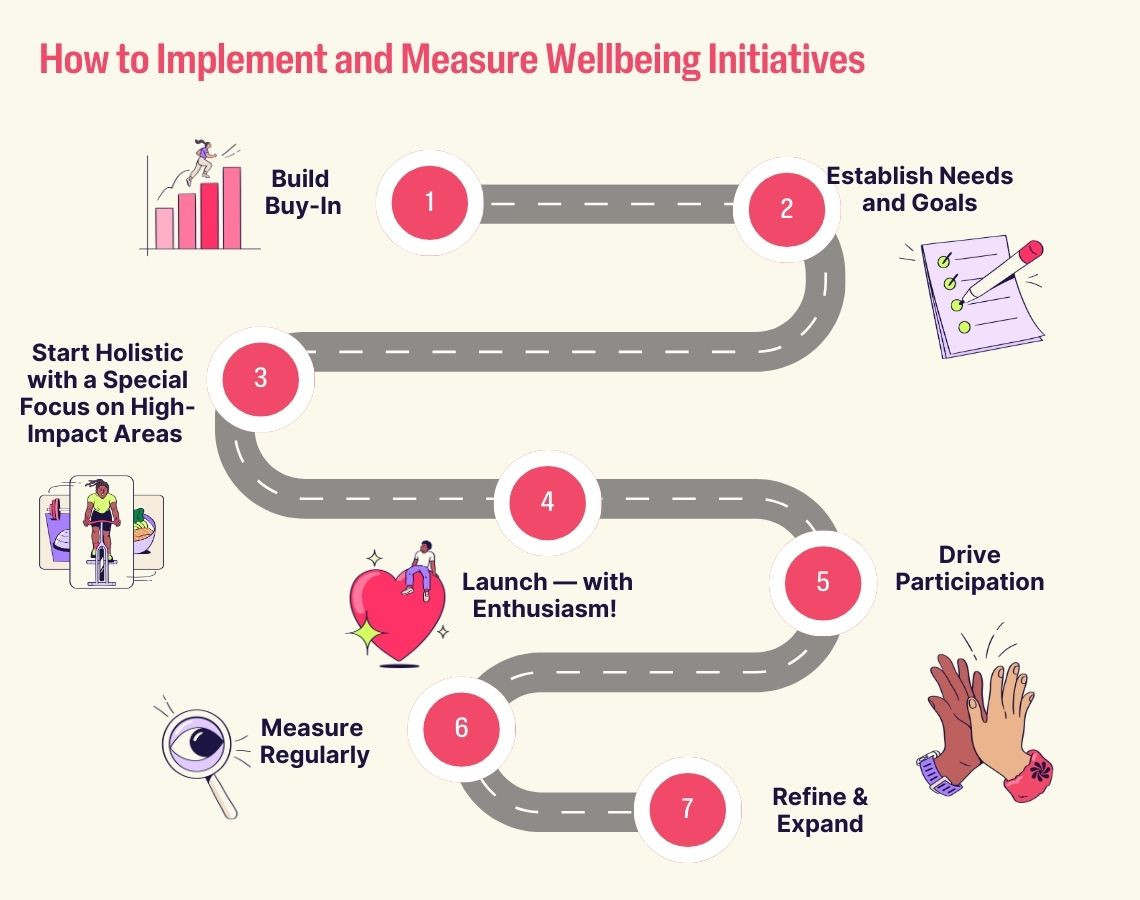
- Get Executive Buy-In and Build a Coalition
Start at the top. Secure support from C-suite and senior leaders by making the business case for wellbeing (use some of the stats in this guide!). It’s crucial that leadership not only approves budgets, but visibly champions the effort. Consider forming a Wellbeing Committee or Task Force that includes stakeholders from HR, benefits, facilities, and representatives from various departments. A cross-functional team ensures broader perspective and buy-in. Remember, C-suite participation is a strong predictor of success – companies where top executives actively engage in wellness programs have employee participation rates nearly double those of companies with low exec engagement (80% vs. 44%). So get your leaders involved as role models from day one.
- Assess Needs and Set Clear Goals
Don’t assume – gather data to understand what your employees actually need and want. Use surveys, focus groups, and existing HR metrics to perform a needs assessment. For example, survey employees about their biggest wellbeing challenges (stress? work hours? financial worries?) and which potential benefits they’d value most. Review your EAP utilization, health claims data, engagement survey results, and turnover stats to spot pain points. Maybe you find stress levels are high in a certain department, or younger employees crave more social connection. Use these insights to define the scope of your initiatives. Set specific, measurable goals aligned to business outcomes: e.g., “Reduce self-reported burnout from 40% to 20% next year” or “Improve engagement survey scores on ‘management cares about wellbeing’ by 10 points.” Having clear targets will guide your program design and give you something to measure against.
We made it easy: Launch your wellness program with this step-by-step guide.
- Start Holistic but Prioritize High-Impact Areas
With needs identified, design a holistic wellbeing program that covers multiple pillars (mental, physical, etc.). However, you may not launch everything at once – prioritize initiatives that address the most pressing issues first. For instance, if your survey shows mental health is a top concern, prioritize expanding mental health resources or manager training in year 1. If work-life balance emerges as a problem, perhaps start with a flexible hours pilot. Ensure you have a mix of quick wins (easy-to-implement changes like meeting-free Fridays) and longer-term initiatives (like a new mentorship program for growth). Also, look at what you’re already doing and integrate or rebrand it under the wellbeing umbrella. Often, companies have scattered perks or policies that, when packaged together, form a strong platform. Consolidation helps employees see the full suite of support available.
- Communicate and Launch with Enthusiasm
A wellbeing program is only as good as its communication strategy. Plan a thorough communications campaign for launch and beyond. This might include an all-hands meeting or HR roadshow to introduce the program, email newsletters highlighting different resources each month, and an internal site or portal where all wellbeing offerings are consolidated. Use positive, inclusive messaging – emphasize that this program is part of investing in everyone’s success. Encourage leaders to mention wellbeing in their talks and updates. You could even give the program a snappy name or brand (e.g. “Wellhub Wellness Advantage 2024”) to make it memorable. Make sure to communicate in multiple formats (posters in the office, chat channels, intranet, etc.) to reach people wherever they are, including remote employees. The goal is awareness and buy-in: employees should understand what’s available and trust that it’s truly supported by leadership.
- Drive Participation through Incentives and Culture
“If you build it, they will come” doesn’t always apply to wellness programs – you need to actively drive engagement. Consider incentives to encourage participation, especially early on. Examples: token rewards (gift cards, extra PTO hours) for completing a wellness challenge or an annual health assessment; team competitions with fun prizes; recognition for wellness “champions” who inspire others. Identify influential employees who can serve as wellness ambassadors, spreading enthusiasm peer-to-peer. Additionally, bake wellbeing into the culture by integrating it into performance dialogues or team meetings (e.g., managers start staff meetings with a quick wellbeing check-in). When employees see their peers and bosses participating (like the CEO attending a yoga class or sharing their steps in a step challenge), it normalizes engagement. Leadership visibility is key – as noted, high leadership engagement correlates with dramatically higher employee participation. So encourage leaders to walk the talk (literally, if you have walking meetings!).
57 workplace wellness initiative ideas to transform employee wellbeing.
- Measure Outcomes Regularly
From the outset, decide on the metrics that will define success for your initiatives. These could include participation rates (what % used the EAP or joined the wellness fair), health outcomes (aggregate biometric improvements, reduced sick days), employee feedback (improved survey scores on wellbeing questions), and business metrics (turnover rate drops, productivity or customer service metrics rising). Establish a baseline for each before you launch. Then, set up a cadence for measurement: e.g., quarterly pulse surveys on wellbeing, quarterly reports on program usage, annual refresh of health risk assessments. Where possible, compare against your goals or industry benchmarks. For example, did turnover in high-burnout departments decrease after implementing work-life changes? Has healthcare claim cost per employee stabilized or fallen year-over-year? Also track ROI in broad strokes: calculate dollars saved from reduced turnover (use that 2x salary metric), absenteeism reductions, etc., versus dollars spent on programs. If 89% of HR leaders see fewer sick days from wellbeing programs, can you quantify that for your workforce? Building an internal wellbeing dashboard for leadership can be very powerful – it keeps attention on the outcomes and justifies continued investment.
- Refine and Expand
Use the data and feedback to continuously improve your wellbeing strategy. Perhaps your initial mental health workshops had low attendance – dig into why (wrong timing? topic not resonating?) and adjust (maybe offer a stress management webinar at lunch instead of after work). Or you might find that a small pilot (like a mentorship program) was a hit – consider expanding it company-wide. Regularly solicit employee input: what do they like most? What’s missing? Keep an open feedback loop via surveys or a dedicated Slack channel for wellbeing ideas. Celebrate your wins too: share success stories, like “Since last year, we’ve reduced burnout rates by 15% and saved an estimated $500k in turnover costs – thanks to your participation!” This not only validates the efforts but also motivates everyone to keep the momentum. As your program matures, you can add new layers (for example, financial wellness might become a new pillar if employees express need). World-class companies treat employee wellbeing as a journey, not a one-time project.
In implementing wellbeing initiatives, diligence and genuine commitment are key. There may be bumps in adoption, or some skeptical managers (“Will this really help?”). That’s why measurement and quick wins help demonstrate value. Showcasing data like 95% of companies see positive ROI on wellness investments or your own internal improvements will convert skeptics over time.
Also, highlight the human stories – e.g., an employee who avoided severe burnout because they used your counseling resources, or a team that improved its engagement after schedule changes. In the end, success is when wellbeing is woven into the fabric of how you do business, and you can’t imagine not having it as a strategic priority.
Critical Lessons from Low-Satisfaction Industries
It’s also instructive to consider what happens when wellbeing is neglected. Certain industries – often those with high stress or traditionally demanding cultures – have historically low employee satisfaction and high burnout.
By examining these, HR leaders can glean cautionary lessons and strategies for improvement:
- Healthcare: The healthcare sector has been under immense strain, especially post-2020. Long hours, intense emotional pressure, and systemic issues have resulted in alarming burnout rates. Between 35% and 45% of U.S. nurses and physicians report symptoms of burnout, according to the National Academy of Medicine, and roughly one in five healthcare workers have quit since the pandemic began. This burnout not only affects workers’ wellbeing but also patient care quality.
Lesson: Organizational issues drive burnout. Poor staffing ratios, excessive overtime, lack of mental health support, and hierarchical cultures all contribute. Some hospitals are learning and implementing changes: enforcing mandatory rest periods, offering peer support groups, improving nurse-to-patient ratios, and addressing psychological safety (so staff can speak up about issues). The takeaway for any industry is that systemic problems require systemic solutions. You can’t yoga your way out of chronic 16-hour shifts or moral distress. HR in any high-pressure industry must advocate for structural changes (hiring, scheduling, leadership training) to reduce sources of burnout at their root.
- Hospitality and Food Service: Restaurants, hotels, and hospitality companies traditionally suffer very high turnover and burnout. The work often involves long or odd hours, lower pay, and high emotional labor dealing with customers. Recent data is eye-opening: over 77% of hospitality workers report experiencing burnout and 40% have quit a job because of it. The hospitality industry also consistently has one of the highest annual turnover rates – often 70-80% in some segments, compared to ~18% across all industries.
Lesson: A major driver here is work-life imbalance and lack of support. Unpredictable schedules, double shifts, and little accommodation for personal life make it hard to sustain wellbeing. Some progressive hospitality employers are combating this by offering more flexible scheduling, greater predictability, and better benefits (e.g., Marriott expanded PTO and added educational opportunities to retain staff). Another lesson is the importance of employee voice – involving frontline staff in scheduling or process improvements can increase their sense of control and reduce burnout. For any organization with shift work or hourly roles, taking a page from these reforms is wise: give employees as much stability and input as possible in their schedules, and invest in their growth (e.g., training, career paths in an industry known for dead-end jobs).

- Finance and Tech (High-Paced Corporate Cultures): Industries like finance (banking, investment firms) and some tech companies have reputations for demanding workloads – the “always on” culture. These attract ambitious talent but often at the cost of wellbeing. It’s not uncommon to see young analysts in finance working 80-hour weeks, leading to rapid burnout. In tech startups, the pressure to scale and wear many hats can similarly drive people to overwork. These industries historically glorified hustle, but that’s changing.
Lesson: Even in competitive fields, unrelenting work without balance is unsustainable. We’re now seeing finance firms experimenting with protected weekends or capped hours for juniors, and tech companies like Google increasing mental health resources and time-off benefits. The broader point is that no industry is immune to employees’ basic human needs. If you ignore them (“If you can’t handle it, leave” attitude), you’ll churn through talent and possibly tarnish your reputation. HR leaders in high-octane fields should push back against archaic notions that long hours = productivity, and present data showing that reasonable rest and wellbeing actually improve output (as this guide has demonstrated). Some investment banks found that mandating at least one day off a week led to better focus and retention – small change, big impact.
- Manufacturing and Frontline Labor: In some traditional blue-collar industries, job satisfaction can suffer due to physically demanding work, safety concerns, and historically less emphasis on “soft” factors like recognition. However, companies like Whirlpool and some manufacturing plants have started to invest in wellbeing (on-site clinics, stretching programs, reward systems for safety and wellness). They’ve seen lower injury rates and higher employee morale as a result.
Lesson: Wellbeing isn’t just a white-collar concern. Physical safety and health are paramount in these settings – a reminder that “Protection from harm” (the first of the Surgeon General’s essentials) is fundamental. HR in these industries should continue focusing on safety protocols and ergonomics as wellbeing measures. Additionally, don’t overlook mental health here – repetitive or strenuous work can take a psychological toll too. Frontline workers benefit from stress management and financial wellness programs (money concerns are a top stressor in lower-paid jobs).
Payactiv’s advice for hospitality (like offering earned wage access or financial planning tools) is relevant broadly: financial wellbeing is a facet of overall wellbeing often under-addressed. Fair wages and helping employees manage financial stress (through education or benefits) can vastly improve their overall satisfaction.
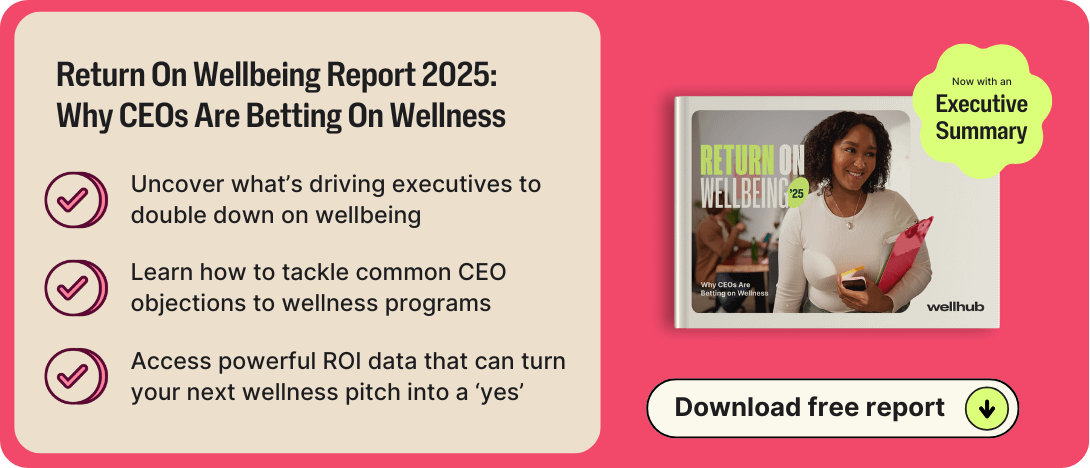
In summary, low-satisfaction industries teach us that ignoring wellbeing has serious consequences – from skyrocketing turnover to safety incidents and lost profits. They also highlight which interventions make the biggest difference: schedule flexibility, adequate staffing, supportive management, and a genuine culture shift from “employees are replaceable” to “employees are our most important asset.”
Even if you’re not in one of these industries, these lessons apply. Ask: Are any teams or roles in my company experiencing similar issues (overwork, high stress, high attrition)? Those pockets might be your company’s own “low-satisfaction industry.” By addressing their specific pain points with targeted wellbeing initiatives, you can prevent small fires from becoming five-alarm blazes.
🦆 Aflac case study: From Medications to Movement: How Aflac Sparked A Culture Shift with Wellhub
Professional Wellbeing Is a High-Performance Strategy
Low professional wellbeing drains performance, drives up turnover, and fuels disengagement. When employees feel burned out, unsupported, or undervalued, productivity dips and healthcare costs rise. Without a clear wellbeing strategy, companies risk losing talent and momentum.
An employee wellbeing program can change that. It gives people the tools, time, and support to thrive—physically, mentally, socially, and professionally.
Speak with a Wellhub Wellbeing Specialist to build a culture where employees feel healthy, fulfilled, and ready to perform at their best.

Company healthcare costs drop by up to 35% with Wellhub*
See how we can help you reduce your healthcare spending.
Category
Share

The Wellhub Editorial Team empowers HR leaders to support worker wellbeing. Our original research, trend analyses, and helpful how-tos provide the tools they need to improve workforce wellness in today's fast-shifting professional landscape.
Subscribe
Our weekly newsletter is your source of education and inspiration to help you create a corporate wellness program that actually matters.
Subscribe
Our weekly newsletter is your source of education and inspiration to help you create a corporate wellness program that actually matters.
You May Also Like

Corporate Wellness Trends HR Must Know for 2026 | Wellhub
See the top 2026 wellness trends shaping performance, retention, and culture—plus how HR can build a unified, ROI-driven wellbeing strategy.

Wellness Points Programs: Boost Employee Health & Engagement | Wellhub
Turn your workplace wellness strategy around with a points program that rewards healthy behavior with perks, from extra time off to gift cards.

Employee Financial Wellness Programs: Ultimate HR Guide | Wellhub
Create an effective financial wellness program that supports your employees in their financial needs, boosting productivity and retention.